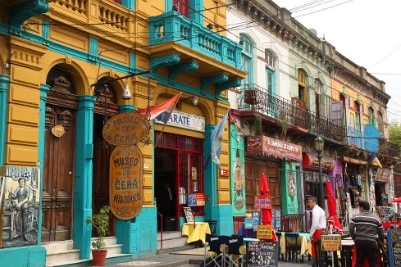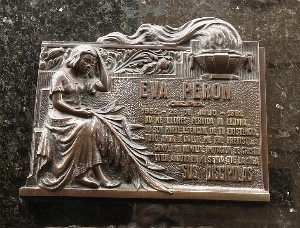We arrived in Buenos Aires yesterday and met up with the rest of our group, so in total we now number 20. They are mostly women from their mid-50’s to early 70’s; we are now 5 men and 15 women, which made for a rather unbalanced tango lesson in the hour after Julio welcomed the group together and briefed us on the trip. My contribution was to flee the room as soon as the lesson started.
There was a welcome dinner later that evening, and through a series of miscommunications we managed to get separated from the group. After assorted phone calls and map consultations we rejoined them at the restaurant and had an Argentine steak dinner; Argentines are really big on beef. The highlight, though, was dessert: you probably didn’t know this, but Argentines are really big on ice cream, too, and do an excellent job of making it. In fact — I am not making this up — ice cream stores in Buenos Aires deliver. You can call them up, tell them what flavors and quantity you want, and they show up at your door a few minutes later. This to me represents one of the pinnacles of Western civilization.
Buenos Aires, though it considers itself the center of the universe, has a somewhat Norma Desmond-esque feel to much of it, a dowager trying to hold on to past glories. It does have it’s charm, particularly the French and Italian architecture that earned it its nickname as “the Paris of South America”. But Argentinians are very proud of their capital; it would not surprise me if they called Paris “the Buenos Aires of Europe”. But judge for yourself: here is the view from our hotel room.

The Paris of South America, after the zombie apocalypse
This picture is actually a little unfair, since there are also beautiful districts of the city with shiny high rises, upscale shopping, and the like. Regardless, the current calamitous state of affairs stems from a long history of bad governance and economic policy incompetence that has left the country in a badly crippled state, perpetually either in or about to be in a state of default. As I type this the government is embroiled in a monster lawsuit with a couple of US hedge funds who bought billions of dollars of Argentine bonds which have now come due. The Argentines are trying to pay off the bond holders in pesos, and the bond holders are having none of it; they want the payoff in US dollars per the original terms of the bonds.

Symbol of the missing, as the grandmothers still march
Certainly the nadir of Argentine governance was during the 7-year “Dirty War” between 1976 and 1983 when the generals were running the country and thousands of their political opponents, as well their opponents’ friends, families, and probably even pizza deliver guys simply “disappeared”. The most tragic of these many cases involved pregnant women whose babies were taken from them and given away, after which the women were (presumably) killed. The situation was so egregious that the mothers of the disappeared started protesting in front of the presidential palace, marching with diapers tied around their heads to symbolize their lost children and grandchildren. They became a powerful force, and when the government was overturned in 1983 they continued to march — successfully — to force the authorities to attempt to identify and recover the lost identities of the missing, and of the stolen children. The effort continues to this day, and hundreds have been identified. The women, some quite aged, still March every Thursday, now with the blessing of the the government. They wear white handkerchiefs on their heads now, and the plaza in front of the palace is dotted with painted versions of their symbol: a stylized white handkerchief (photo at right). Our local guide, a voluble Argentine woman named Sylvana, had difficulty maintaining her composure as she explained all this to us.
One of the consequences of the collapsed economy is a thriving currency black market. The official exchange rate is 8.4 Argentine pesos to the dollar. But Julio and Sylvana said, screw that, you can do a lot better. They took us to a so-called “blue market” exchange, where a scruffy looking guy behind a thick glass window gave us 13 pesos per dollar. That’s a big difference, and so he makes his profit by in turn selling the dollars one more layer down the economic food chain, on the actual black market, where he gets God knows what for them. His blue market operation is technically illegal but winked-at as long as he keeps a low profile; there was not a single sign indicating a currency exchange, but rather a dusty display of sunglasses in a plexiglass case. So he is notionally selling sunglasses, though I would be shocked to learn that the display case had ever once been opened.

Madonna sang here
The presidential palace has a baroque architecture and is an unattractive pinkish color. On the second floor are a series of balconies facing the plaza, which the president can use to address the presumably adoring throngs. The balconies are dark, except for one (photo at left), that being the one from which Eva Peron addressed her particular adoring throngs. The lights are kept on in her memory, and no president since then has had the cojones to use that balcony. (For one thing, explained Sylvana, you don’t want to do that unless you’re quite certain that the crowds below are entirely on your side, and that just does not happen anymore.)
Eva “Evita” Peron was a much loved character, as you know, who in the seven years that she was married to Juan Peron (26 years her senior) was a transformative influence for workers and women’s rights. She died in 1952 of cervical cancer at the age of only 33 and to this day remains a controversial and iconic part of the Argentine national psyche.
(True story: Julio tells that us that in a previous tour group when he told them that Eva Peron died in 1952, a woman in the group said, “That’s impossible! I just saw her perform in a show!” I neglected to ask whether Madonna was loved or loathed here.)
Adjacent to the plaza in front of the palace is a Catholic church (the country is 80% Catholic) with an unusual display: a memorial to Jewish terror victims. In 1992 Hezbollah blew up a synagogue in Buenos Aires, and to memorialize the victims the bishop of this church created a display consisting mostly of pieces of paper: loose pages from prayer books, notebooks, and music sheets from the synagogue that were strewn about the street in the blast.
After leaving the church, we rode a few stops on the Metro — from 1913, the oldest in South America, and strongly resembling the Paris Metro with its tiled walls and murals by local artists — and then boarded a bus for a few hour city tour.

I’ll take dinner here, thanks
Now you might wonder why we had to get on the Metro to reach the bus. And the answer is that from a purely practical perspective we didn’t; the bus could have picked us up at the palace. But our tour operator OAT goes out of their way to find out everyone’s individual interests and accommodate them — they ask us to fill out “expectation cards” with that kind of information — and at least one member of our group had expressed an interest in experiencing local public transpiration. So we did!
The bus took us to a number of districts around the city, but our first stop was a heavenly little bakery where we marched inside to breathe in the sugar and the butter and the calories, and where Julio and Sylvana bought a couple arm loads of assorted pastries for us. They were seriously good (photo of one variety at right).

Boca district, touristy but fun
Our next stop was the Boca district, originally populated by Italian immigrants and still very colorful. It’s a large residential area but also has a tourist-centric neighborhood, all brightly colored walls, artists displaying their wares, and tango dancers in the streets. The picture at left gives you the idea.
The street was alive with people, probably half tourists and half people trying to make money off the tourists; the latter include shop and restaurant owners exhorting passers-by to enter; shills passing out leaflets for other shops and restaurants; and tango dancers inveigling you into having your picture taken with them. (The tango pairs were all in 1930’s tango garb; men in low-slouched fedoras and right three-piece suits; women with black air, diaphanous thigh-high-cut dresses, and 7′-long legs.)
One of the curious tropes of this particular area was a proliferation of somewhat grotesque statues, sometimes of famous people and sometimes not (an example of the latter being, say, a chef statue in front of a restaurant.)

Three local gods smiling upon the hoi polloi
The pope is a popular subject of these three-dimensional caricatures since he is Argentine; one street corner had one of these statues of him leaning out a second story window apparently giving a benediction to the crowd below. But he popped up in a number of other places along the street as well. At right you can see three of these statues smiling down from a balcony, a sort of Argentine pop culture trinity. From left to right they are soccer superstar Maradona; the inevitable Eva Peron; and tango demigod Carlos Gardel (who has a whole tango theater named after him.)
Our final stop on the bus tour was the Recoleta District, an upscale shopping and park area whose most famous venue is the city cemetery. The cemetery is kind of an odd place, rather different in appearance and atmosphere from most you have seen. It has no open green space at all, but is instead a narrow gray maze of tall mausoleums and columbariums. A network of pathways barely six feet wide winds in shadow among the discolored marble, gray slate, and black granite tombs. A small number are clearly still maintained, with recently fresh flowers placed at their doors. Most look more like props from a vampire movie. Adding to the general eeriness is a number of feral cats who sort of keep watch over the place, like this:

No, this is not an illustration from a Stephen King novel

Oh, what the hell, go ahead and cry for me, Argentina
You get a sense of the layout from the tombs in the background. Thee are a number of locally famous personages at rest in this particular cemetery but the big draw is Evita herself, the mausoleum of Eva Peron. It is very unprepossessing, situated in the middle of an unremarkable row of other tombs. She is not even there by herself; it’s actually her family mausoleum, the family Duarte (her maiden name). Part of the reason that she is not more prominently placed is that after her death her body went walkabout, not in the zombie sense but more like in the grave robbing sense: her supporters didn’t want her enemies (of which she had many) getting a hold of her and so shipped her body abroad. Despite being dead she ended up making a grand tour of about four different countries over a period of something like 21 years. By the time her remains made it back to Argentina, hubby Juan had not only outlived her by a long time but had gone through another wife in the interim. So when her family requested that she be placed in the family tomb, General Peron said, like, whatever. So they did, and here is the proof that we visited her (pic at right). There were a number of wilted flowers at the front of the tomb; apparently they get refreshed every Sunday, and we were visiting the day before that was scheduled to happen.
Our final event of the day was a home dinner visit to a local family. This kind of cultural immersion is a feature of every OAT trip (we visited a family compound and a school in Zimbabwe two years ago). The 20 of were divided among four host families. Our host family was extremely pleasant and probably rather atypical in being clearly very well off. The family consisted of the mother (our hostess), father (a lawyer who was not present), and two teenage (16 and 17) daughters, only the younger of whom was present. They live in a very nicely appointed 1750 square foot, 4BR 3 bath condo with a private elevator down to the lobby. So not exactly peasant stock, in other words. Mother and daughter spoke articulate English, had strong political views (they hate the corrupt, incompetent government), and were excellent hosts. I’m not sure how well they represented the views and overall life situation of the general population, but we enjoyed the evening.
Tomorrow we fly more or less literally to the ends of the Earth: Ushuaia, billed as the southernmost city in the world and the jumping off point for our boat trip around Cape Horn and through the Beagle Passage to the Patagonian ice fields. It is likely that we will fall off the grid when we arrive there, so I will try and keep this blog updated offline and post it when Internet access allows.


You mention the color of the “Casa Rosada” palace. Several sites say the color was a combination of the representative red and white of opposing political factions, to create a compromise color. But, in my Miami days, I saw a number of more or less garish pinkish buildings. The story I head was that the original color used was like the more intense ones you see today, chosen because it was locally made and readily available. The older buildings have faded from the sun. The louder colors today are the results of “improvements” in paint that resist fading. So today, those seeking a more authentic color make the mistake of starting with a much deeper shade, which is correst, but they often neglect the fading. Hmm, what’s my point? One, the original color of the palace was probably much more “unattractive”, though the builders might have targeted something closer to the current faded pink.Two, who can resist trying to catch a point where you uncharacteristically didnt trace something to it’s obscure origins 😉